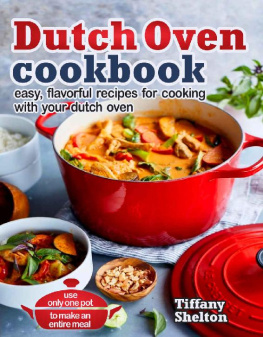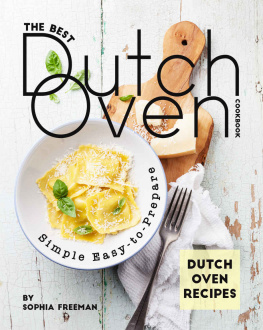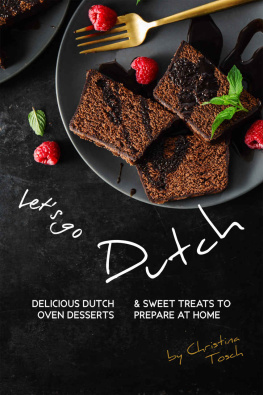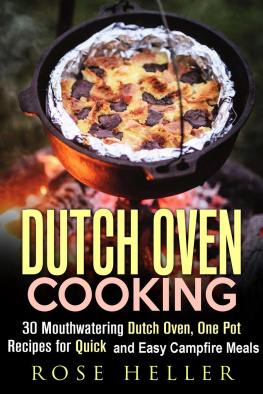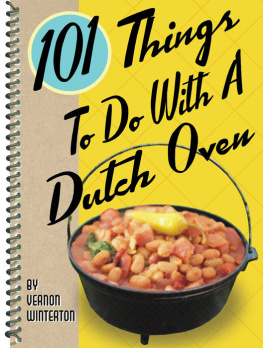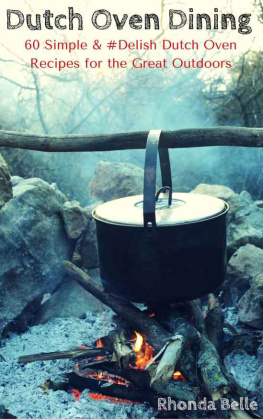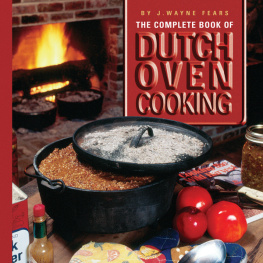T odays home cooks are exposed to what can seem like an endless array of cookwaredifferent materials, different designs, and different pieceson cooking shows, shopping networks, or online. Some buy a lot of cookware, and some dont, but one thing that experienced cooks agree on is the importance of having a few really dependable, versatile tools.
The Dutch oven is one such tool; in fact, some would claim its the only pot you need. Its great for everything from braising to slow-cooking stews to soupscooks rely on it to produce an amazing variety of meals. Dutch ovens usually have loop handles and flat bottoms, and always come with lids. They are approximately four to five inches deep and range in capacity from two to thirteen quarts. A Dutch oven in your kitchen will help you to cook perfect meals to amaze all your family.
For our cookbook, we are bringing the Dutch oven indoors. Here you can find delicious recipes for breakfast, lunch and dinner. So, let's get started!
CHAPTER 1. The Basics
Brief History of the Dutch oven
Dutch ovens as we know them today were developed in the early 18th century. The use of heavy cast iron cookware was highly regarded in Europe, as heat was evenly distributed through the pot, and there was a rapidly growing demand for cast iron cooking pots in America. The iron stove had not yet been invented and most cooking was done on hearths of fireplaces, outdoors over campfires, or over open fires in a lean-to behind a home. A cast iron pot was emerging that was ideal for this type cooking. It was flat on the bottom, had three legs to hold the pot above hot coals, and had a flat lid upon which to place hot coals for baking. Paul Revere has been credited by some writers with making many of the improvements of the early oven. The Dutch oven as we know it today was being born.
No one knows for sure where the name Dutch oven originated. Perhaps the most plausible explanation, as reported in John Ragsdale's book, Dutch Ovens Chronicled, is that in 1704 English foundry owner Abraham Darby traveled to Holland to inspect casting of some brass vessels in dry sand molds. Holland had more advanced foundry technology and many thick-walled, heavy cast iron vessels were imported into Britain. From this observation, and after some experiments, Darby perfected a method to cast iron vessels in dry sand molds. In 1708 he patented the process and soon began producing a large number of cooking pots. By the mid-eighteenth century, these pots were being shipped to the colonies. They were first referred to as Dutch pots, and later, Dutch ovens.
Another explanation is that once the improved cast iron cooking pot became popular in America, British and New England manufacturers began producing it in large numbers. Dutch traders traveled throughout the American colonies and frontier, and peddled the pots, thus the name Dutch ovens.
There are several other theories as to how the name came about; however, we will never know for sure. The one thing t we do know is that the name stuck and has been in use for almost three centuries.
When Americans began exploring further west, the Dutch oven became a popular tool for the mountain men and Native Americans. In fact, it was reported by some that George Washington used Dutch ovens to feed his troops during the Revolutionary War.
Joseph Lodge, in 1896, built a cast iron foundry in Tennessee and the Dutch oven fast became his leading product and, in fact, is still the best producer of Dutch ovens.
Recently, the Dutch oven has been replaced with more advanced kitchen cooking vessels and appliances; however, the great taste of a meal cooked in a thick-walled cast iron pot with a tight fitting lid cannot be replicated, so the camp oven, as it is commonly referred to, is still used by many across the globe.
What Is a Dutch oven?
Dutch ovens have been around for so long in so many kitchens that they might seem too old-fashioned for todays cook. In many peoples minds, the Dutch oven is a quaint relic from more traditional times. But for many cooks, along with a desire to cook healthy meals at home there is a desire to simplify their cooking and their kitchens. Perhaps as a backlash to the multitude of products available, the modern kitchen is the minimal kitchen, where less is more. Dutch ovens then become invaluable to todays cook. When you can use one pot to make an entire meal, dinner doesnt seem like such an onerous task.
In the broadest terms, a Dutch oven is a heavy pot with short handles and a lid which can be used both on the stove top and in the oven. Although they can be made from different materials, the most popular Dutch ovens are made from cast ironthat is, iron cast in dry sand molds. Iron is an extremely dense metal, slow to heat up, but also slow to let heat go. This quality helps reduce the temperature fluctuations when compared to other cookware. While uncoated cast iron ovens and camp ovens require seasoning before use and must be hand-washed, more modern enameled cast iron Dutch ovens are rustproof, dishwasher safe, and require less maintenance. By nature, their smooth surface is stick-resistant and they can be used right away, with no seasoning needed.
Dutch oven can produce some relatively quick weeknight meals, but it truly excels in recipes that call for long, slow cooking, like soups, stews, and braises. The density of cast iron keeps the temperature of these dishes constant with little to no attention, whether youre cooking on the stovetop or in the oven. While it may take an hour or more for a dish to cook in Dutch oven, after the initial prep work you can ignore it for long periods of time and still end up with fantastically flavored meals. With some care it cleans up easily, and since many meals can be cooked start to finish in one Dutch oven, youre not left with a sink full of dishes after dinner.
Dutch ovens come in sizes from 1 cup (Le Creuset sells tiny individual pots made just like their big brothers) up to a 15-quart goose pot that is not only large enough to cook a goose, but also to bathe a small child. Realistically, though, most cooks consider sizes between 2 quarts and 7 quarts, with the 5- to 6-quart sizes being the most popular.
When youre cooking for two, it might seem that you want to stick with the smaller sizes (2 quarts to 3 quarts), and in some cases these smaller sizes are ideal. However, for many recipes, a larger size is betterfor instance, you cant cook pasta for two in a 2-quart pot. I tested the recipes in the book using a 5-quart and a 6-quart Dutch oven, but with very few exceptions, the dishes will turn out fine in any size pot from 3.5 quarts up to 6 quarts.

